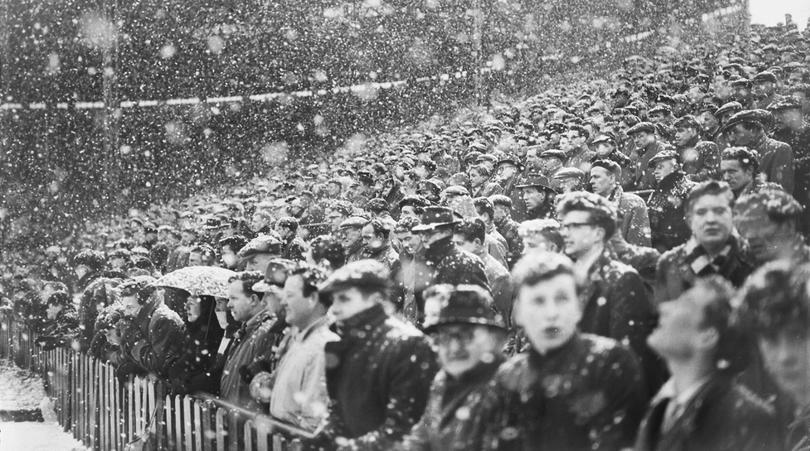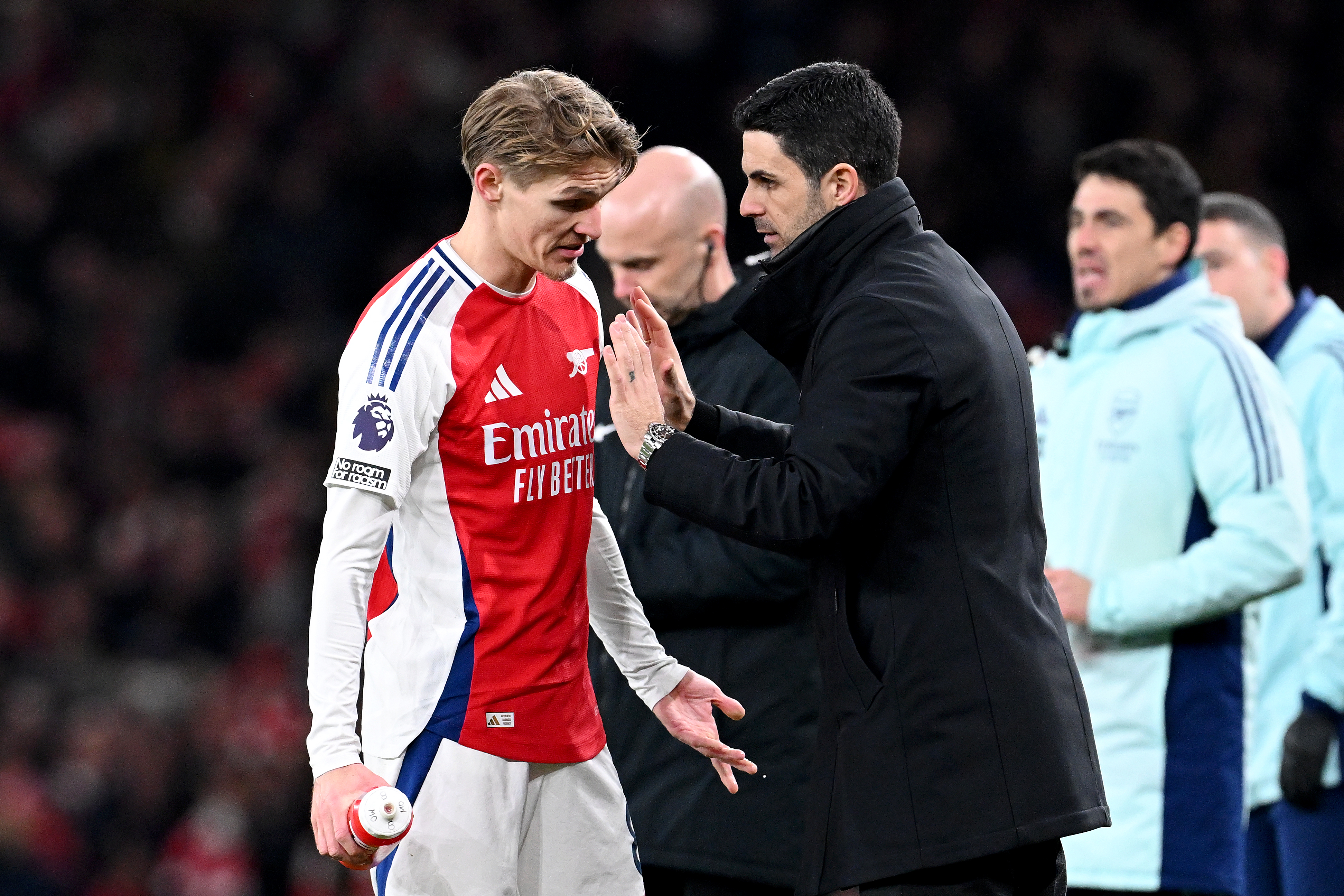Inside FC Santa Claus: Lapland’s favourite football team – who are finally getting serious
We're approaching that most wonderful time of the year, but for the most festively named club in football, the 2016 season was not always one of goodwill. FFT went to Lapland to learn why – and about the exciting developments which could make such misery a thing of the past
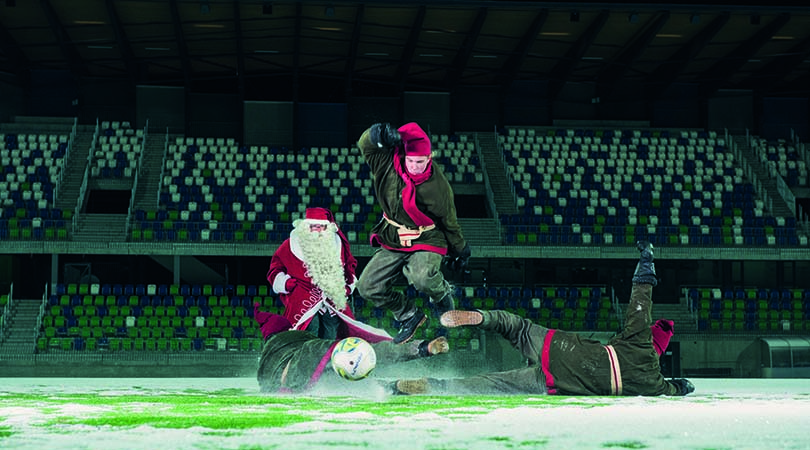
Photography: Konsta Leppanen
There’s a wry smile on the face of Tomi Koski as he prepares to pose for pictures for FourFourTwo. Christmas is drawing near, and that can mean only one thing. Time for the weird photoshoots.
“Last winter I was standing in one metre of snow, in the forest, with my full kit on,” he says. “And I was thinking: ‘I’m a footballer, so why am I standing here?’ But I’m used to it. It’s fun. Other clubs don’t get to do these kinds of things.”
This evening, the players of FC Santa Claus are clambering into some elf costumes for a spot of training on a snow-covered pitch at the smart Keskuskentta stadium, the main football venue in the picturesque city of Rovaniemi, as Father Christmas himself looks on with interest.
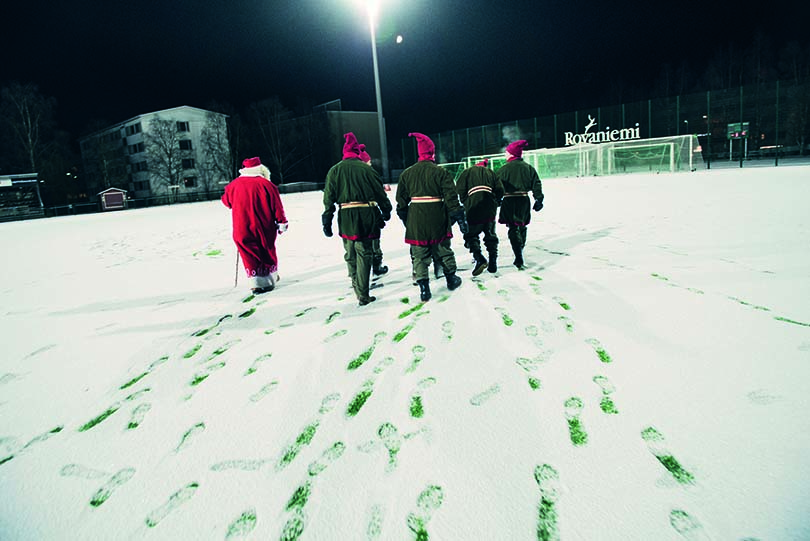
Through necessity, the club’s real season ended several weeks ago on October 1. We’re in Lapland in the far north of Finland, where the temperature has already plunged to minus 10 degrees. It has been known to get as cold as minus 38. But despite a lack of actual fixtures, this is peak season for the globe’s most Christmas-themed football club. Unsurprisingly and understandably, almost all of the interest from the outside world comes in the lead-up to December 25.
This year, it’s probably just as well that their season itself went under the radar. Defender Juho Saukko laughs nervously when FFT asks how they did in 2016. “You can look at the league table,” he says. “It didn’t really go well.”
Ho, ho, h-oh, no
Get FourFourTwo Newsletter
The best features, fun and footballing quizzes, straight to your inbox every week.
Indeed it did not. FC Santa Claus, founded in 1993, spent the 2016 season in the third tier of Finnish football. After several experienced players left the club, they picked up only eight points from 22 games, and conceded 102 goals. Relegation was inevitable, and they finished 19 points adrift of safety after losing their last 13 league encounters.
“It was something like that – I wasn’t counting, to be honest,” says Koski, the team’s captain and, at only 26, the oldest player. “I don’t know what happened. It’s a very young team, and once we lost three or four games in a row it was hard to get the lads to focus.”
Among the defeats was a 9-0 loss to Hercules, managed by former Everton and Nigeria striker Daniel Amokachi, and whose team finished eighth in the 12-team league. Then came the biggest humiliation: a 16-0 thrashing to Kajaani in the campaign’s penultimate fixture.
After several experienced players left the club, they picked up only eight points from 22 games, and conceded 102 goals. Relegation was inevitable
“It was terrible,” says 18-year-old Saukko, who was stepping up to play senior level for the first time in 2016. “I played in that game and people still ask me, ‘Were you in the team that lost 16-0?’ But we had a lot of injuries and we didn’t have enough fit players.”
“At that point in the season, everyone had pretty much given up,” Koski reasons, as he ponders why just the 11 FC Santa Claus players turned up for that match, a four-hour bus ride away. “There were some lame excuses why people couldn’t come to the game. I guess everyone knew we were going to lose and didn’t really want to go.
“We had to play three goalkeepers in the starting line-up. Two of them played up front. They tried their hardest, but if you’re a goalie, then even if you’re good with your footwork you are not close to the level needed to play outfield.
“That game was really embarrassing. It was six or seven minutes until the first goal and before then I believed we’d do all right – it was fine. Then the first one went in and I thought, ‘Here we go.’ The goals started coming. They did hit the post once, but then scored with pretty much every other shot they had.”
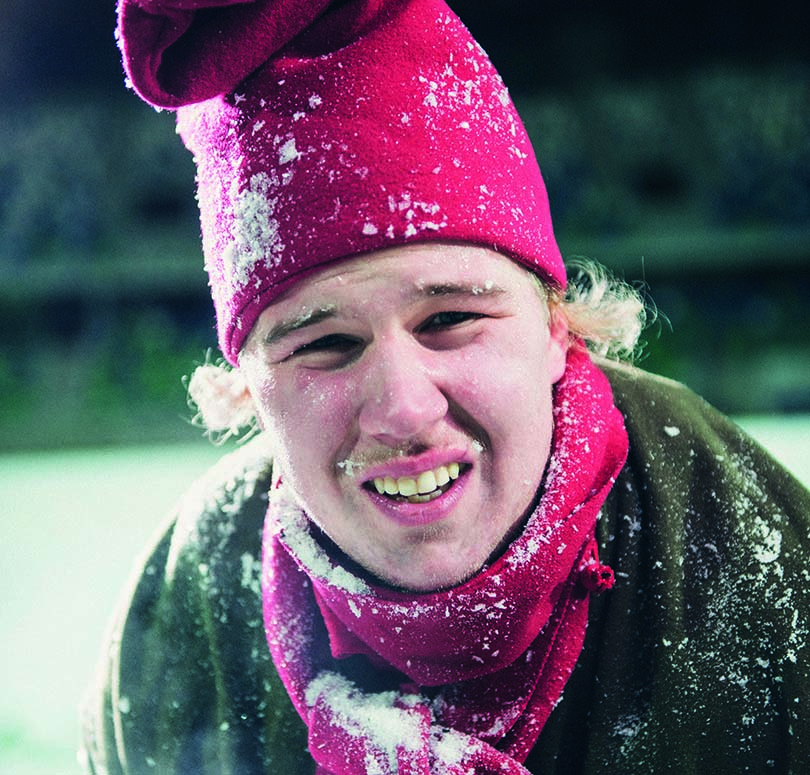
At least FC Santa Claus will never run out of men to stand between the sticks: they have five goalkeepers in total, two of whom were unavailable that day. Mikko Rantala couldn’t make it because he was behind bars in Vegas – the local casino Feel Vegas, that is, where he works at the heavily fortified cashier desk through to the early hours.
“It’s been tough for Mikko,” Koski admits. “He’ll be working until 4am. Once, we had to leave for a game at 5am, so he came straight from work and slept on the bus. Has he ever fallen asleep during a game? Maybe if we kept the ball he would, but there’s so much traffic in our penalty box that I can assure you there’s no chance!”
Rantala bemoans the club being so far north. “A lot of the other clubs come from the south,” he grumbles. “We travelled 10,000km on the bus last season. It’s hard on my ass, sitting like that for so long. But we’re all friends at this club. Here the name is normal, although when I told my girlfriend that I played for FC Santa Claus, she laughed.”
We travelled 10,000km on the bus last season. It’s hard on my ass, sitting like that for so long
She wasn’t the only one to smirk at the name. Koski adds: “You do hear some really lame jokes from our opponents about Santa Claus, elves and reindeer. Maybe some teams try harder against us, as well. They probably think it’s embarrassing to lose to us.”
Being good boys
In 2017, FC Santa Claus will drop down to the fourth tier – the division they escaped two years ago. The club’s 23-year history has been spent bouncing between Finland’s third and fourth levels.
They were formed from a merger between two local football teams in Rovaniemi, the capital of Lapland, which has a population just north of 60,000. Lapland has long been the home of Santa Claus according to Finnish folklore and, although he was originally claimed to reside in Korvatunturi a further 150 miles north-east, the Santa Claus Village amusement park was opened in Rovaniemi in 1985.
Lapland has long been the home of Santa Claus according to Finnish folklore, although he was originally claimed to reside in Korvatunturi a further 150 miles north-east
Tarho Iljin, one of the founders of the new football club, sensed an opportunity. “When we were founding the club, I was the one saying we should make it FC Santa Claus,” recounts Iljin, who still watches most games from the stands. “Everyone thought about it for a while and agreed. We wanted it to be a thing for the future.”
Today, the 68-year-old is proudly sporting an original FC Santa Claus tracksuit from the 1990s. It features the original club badge, which shows a waving Santa controlling a football. These days, Santa has grown tired of all that waving, and a new crest features him writing at a desk – his ‘naughty’ and ‘nice’ lists, presumably.
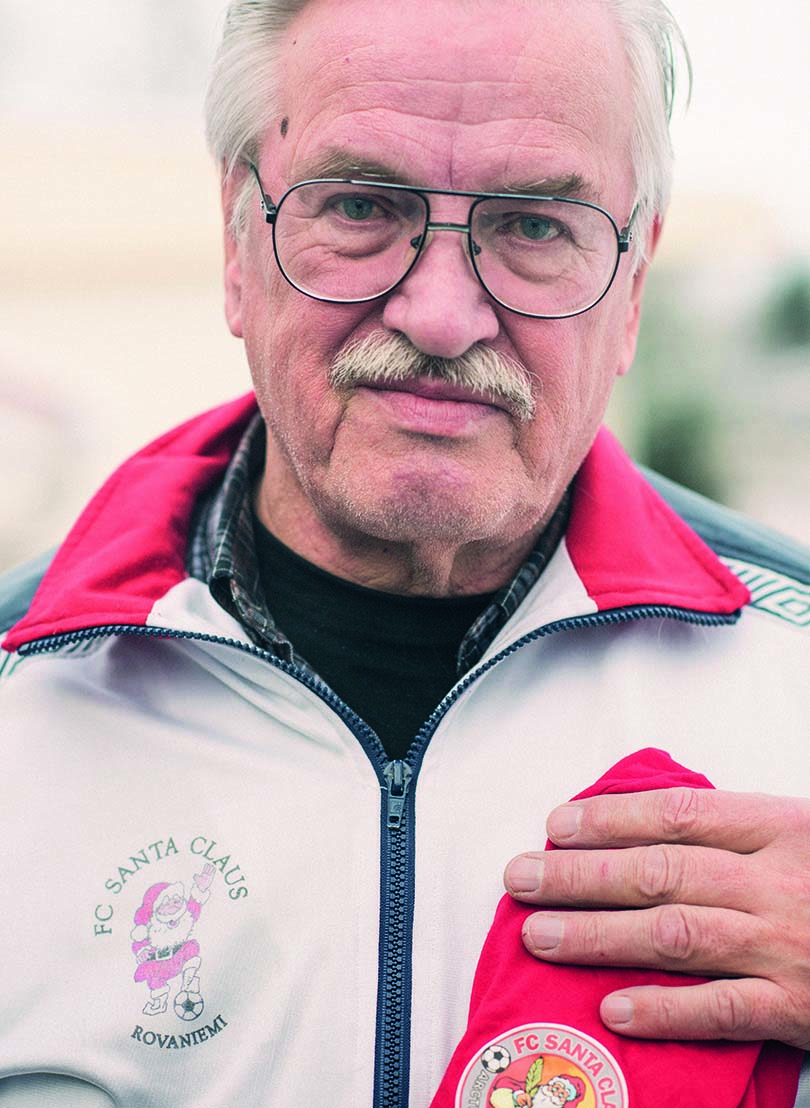
Iljin has played quite a significant role in the growth of the Santa Claus brand in Rovaniemi – a new hotel here was named Hotel Santa Claus after he suggested it, too. FFT is staying at the affiliated Hotel Rudolf. It’s hard to go anywhere in the city without being confronted with some reminder of Christmas, even during the summer. Tourist numbers grow all the time, particularly in December.
However, the club’s name of FC Santa Claus AC – the AC stands for Arctic Circle, rather than being a homage to AC Milan – did need the approval from Santa himself. Fortunately they didn’t have to go far to get it: Saint Nick has been based at the Santa Claus Village just a couple of miles north of the city, straddling the Arctic Circle line, ever since it opened.
The club’s name of FC Santa Claus AC – the AC stands for Arctic Circle, rather than being a homage to AC Milan – did need the approval from Santa himself
Everyone we speak to in Rovaniemi is at pains to point out that he is indeed the real Santa, and he even welcomes FFT into his grotto for an exclusive, if surreal, interview.
“They are all very good friends of mine, so I gave them my name to use,” Santa explains when asked about FC Santa Claus, who play in red and white. “A long time ago we had a little negotiation about it, but it was very short – I said yes. When I was young, I played a bit. What position? Well, in those days we didn’t have any positions; there were just a few of us in a swamp, running around.”
We feel the question has to be asked: what does Santa make of his affiliated club’s awful form? Is Christmas cancelled?

“No, no, success and being good boys are two different things. A lot of people have been successful but do not even ask me if they have been good,” he says, on the day that Donald Trump has been elected as the new president of the United States of America.
Sadly, the big man – that’s Santa, not Trump – has too many other commitments to ever take a hands-on role at the club; he is merely a figurehead. Occasionally he will turn up to perform a ceremonial kick-off, as well as posing for pictures with the players, including for their profile pictures on the club’s website.
“I’ve been to a few of their games, but over half a million people from all over the world visit me every year, so that keeps me pretty busy,” he boasts. “It’s quite a lot of people each day when you divide by that 364 – because for one day a year I’m away from here, for certain reasons.”
While Father Christmas doesn’t have a hands-on role at the club, Juha Etelainen certainly does. Like the players, the club secretary is a volunteer – an enthusiast. He’s also a man who remembers the heady days when 5,000 spectators turned up to watch FC Santa Claus play a summer friendly against Crystal Palace back in 1997. The average attendance these days is closer to 60.
I’ve been to a few of their games, but over half a million people from all over the world visit me every year, so that keeps me pretty busy. It’s quite a lot of people each day when you divide by that 364
“Many teams from the UK used to come over and play in Finland,” reminisces Etelainen, adding that West Ham also visited for a game. “Now teams go to Thailand or China instead as it’s much more lucrative. Maybe teams in the English second or third division could still visit us, though. Summer here is great.”
The club’s highest point came in 2010, when FC Santa Claus came top of the third tier and were agonisingly close to promotion, only to concede a late goal in their final play-off match.
“The team who beat us that day, HIFK, from Helsinki, are now playing in the Finnish Premier Division,” Etelainen reflects wistfully. “There were three teams in those play-offs and both of the other teams eventually got as high as the Premier Division. Sometimes you get to a crossroads and go in a different direction than you hoped.”
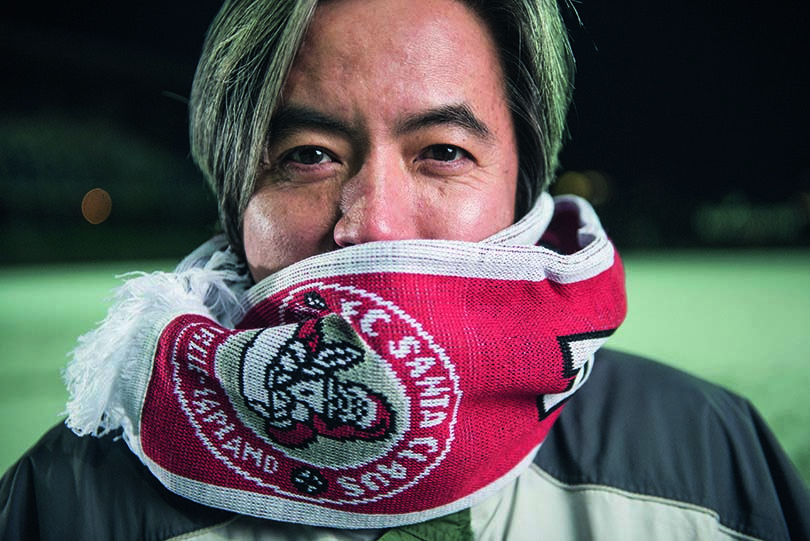
Santa Claus is coming to China
After failing to win promotion six years ago, FC Santa Claus soon ran out of money and went bankrupt in 2012. Etelainen thinks the club overstretched themselves, paying to recruit some players without having sufficient local income to fund wages. He quickly helped to get the club back on its feet, and his main role now is to generate investment from around the world.
If the novelty of FC Santa Claus has largely worn off at home in Finland, it continues to attract interest from different countries. A group of fans visited from Italy to watch a match, while 500 people have signed up to the club’s membership scheme, a figure they hope to increase to 5,000. Members receive hats and football kit in return for their support; the club are also working to create an online merchandise store.
Furthermore, both Puma and EA Sports previously agreed one-year partnerships with the club. Etelainen hoped the latter would lead to their inclusion in FIFA 16. Sadly, it wasn’t to be.
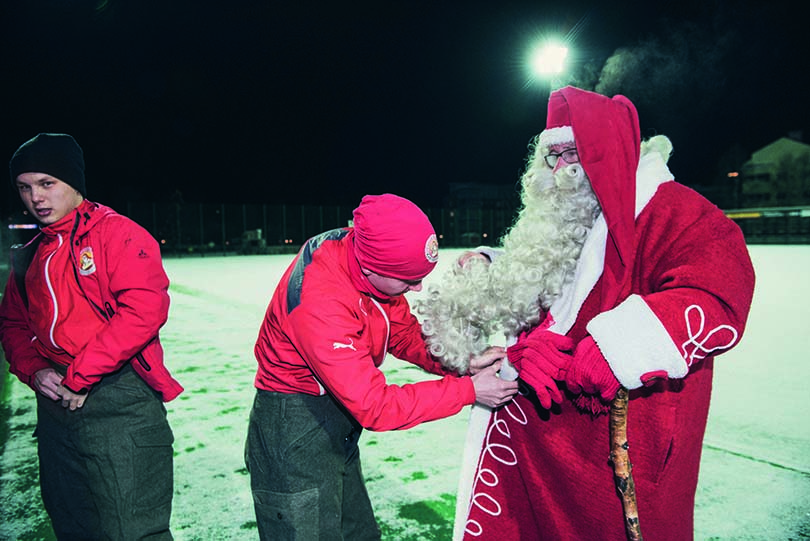
The biggest breakthrough came 12 months ago when the CEO of the Chinese multimedia company Bewin Sports got in touch with the club, explaining that he had read an article and was very keen to get involved. A five-year shirt sponsorship deal was agreed.
“It’s crucial for us,” Etelainen says. “Marc Gao called me. He had been travelling to Finland for 10 years, because Helsinki is the shortest route to Europe from China. Now he’s the main sponsor of the club and our vice-president. We did the first press conference at Chinese New Year, at the Bird’s Nest stadium in Beijing. There were 50 different media organisations there – all for us, from the third tier in Finland. Last week I went to Beijing for another press conference.
The club’s highest point came in 2010, when FC Santa Claus came top of the third tier and were agonisingly close to promotion
“On Christmas Eve we’re going to play a charity match over in Beijing: snow football against players and a group of celebrities from China, in a 60,000-capacity stadium. It will be broadcast on Chinese television, so we will get real exposure there. It’s like a fairytale, it really is. The real Santa is Mr Marc – he is making all of our dreams come true. But that is the potential we have. Since I started working on it, there have been reporters and people calling me every year.
“Our club motto is ‘Don’t stop believing’. Mr Christmas says that. We haven’t stopped believing, and now it is paying off. We’ve been struggling for many years, and many local people said, ‘Well, it’s nice that you are seen by people, but where is the money?’ Finding money locally is hard, but we don’t have to do that now because the money is finding us from abroad. Things are changing.”
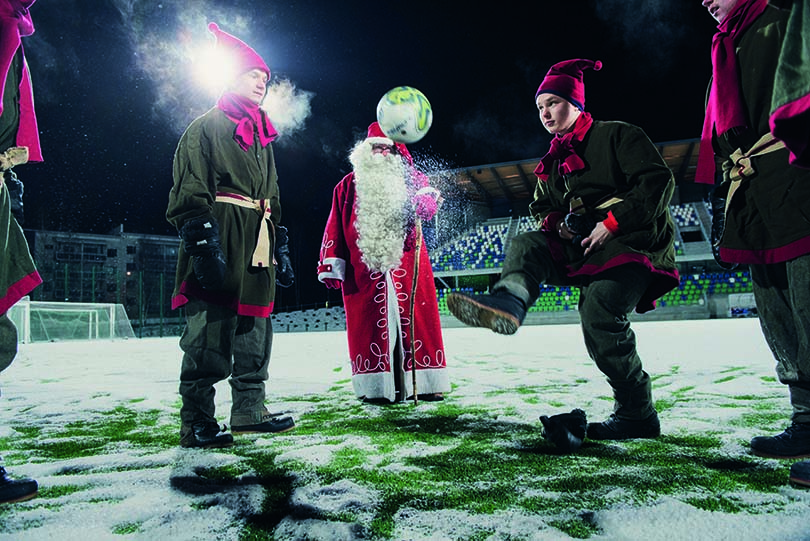
Gao is visiting from China while FFT are in Rovaniemi, with a reporter from Chinese TV station CCTV in close quarters, so Etelainen drives us over to meet them. They’re spending the evening at the home of local songwriter Kimuri Maunuvaara as they work on a special Christmas song to boost FC Santa Claus’s popularity in China. Tomorrow they are heading to the Santa Claus Village to film the video, featuring a love story between a Chinese boy and a Finnish girl.
FFT is welcomed in and given some reindeer soup as Gao explains why he got involved, when Christmas isn’t an official celebration in China and only 2.3% of the country are Christians.
“Christmas is like a festival in China – not a religious thing,” he says. “That’s why I wanted to use FC Santa Claus, because Christmas means happiness and giving gifts to the children. This is the 11th time I have visited Rovaniemi since last December. I have many friends here now. The club have a plan to be bigger and bigger. Next year, I will also find another Chinese sponsor for the club. We have a long plan, over five years, to be better and better, step by step.”
Christmas is like a festival in China – not a religious thing. That’s why I wanted to use FC Santa Claus, because Christmas means happiness and giving gifts to the children
Girls, beer and Santa
That plan doesn’t just involve music videos and matches against celebrities. While there will always be a place for the unusual at FC Santa Claus, they are getting serious, too. The club plan to work closely with the city’s sports institute – Santasport, naturally – and Rovaniemi’s Premier Division outfit, RoPS.
Players from around the world regularly write to FC Santa Claus to ask for a trial, but the club’s focus is on developing local talent. They will take on some promising young players and the institute will provide them with qualified coaches.
We did the first press conference at Chinese New Year, at the Bird’s Nest stadium in Beijing. There were 50 different media organisations there – all for us
FFT heads to Santasport’s indoor hall to meet up with the club’s newly appointed coach, Vesa Tauriainen. The bespectacled former Finland international has the look of a professor as he studiously puts a number of youngsters through their paces. Saukko is the only outfield player from FC Santa Claus at training, as others are at work, so he has linked up with RoPS players to do some drills.
“It’s nice to coach FC Santa Claus, but it’s a big responsibility,” Tauriainen admits. “People look at the team and think, ‘Are they serious or is it only a hobby?’ We don’t want that, we want to take it seriously. We have to start again. It will be quite a young team; we have to look ahead for three, four or five years. We have some good young players here who have a chance to play at a higher level, but if we don’t try to improve them as players, it will just be a hobby for them – girls, beer and Santa.”
The institute want to help the club make progress up through the leagues, believing their best young players could then go on to play for RoPS. They hope FC Santa Claus will enjoy a successful 2017.
“They can’t do worse!” laughs Antti Vikander, who is overseeing the link-up and heads up the local football development scheme, which is called – yes, you’ve got it – the Santa Claus Grass Roots Programme. “The ideal situation would be that RoPS remain in the Premier Division, with FC Santa Claus among the best teams in the third tier, or mid-table in the second division, because then you will have a suitable step to the Premier Division.”
It’s nice to coach FC Santa Claus, but it’s a big responsibility. People look at the team and think, ‘Are they serious or is it only a hobby?’
A local grass-roots programme includes the Santa Claus Cup. This year, the junior tournament attracted teams from seven countries, including China and Spain. Played in the middle of the summer, when the sun doesn’t set for a full month, some games end as late as 2am.
For FC Santa Claus, their visit to China means that this will be their first Christmas away from home. “I’ve never been to Asia,” muses captain Koski. “When they told us a few months ago about the trip, we thought, ‘Yeah, right – like that’s going to happen.’ But apparently it is. It’s crazy – I’ve never heard of anything like this happening for a Finnish club. The biggest ground I’ve played in holds maybe 5,000 people. I can’t imagine what it will be like.”
Etelainen adds: “People always say, ‘Why are you doing things like this? Why don’t you just concentrate on basic things?’ But without doing these different things, we can’t grow. Then we’re just a team in the third or fourth level, and we’ll stay that team all the way to the end. By doing these different things, we can make people smile, and hopefully they’ll be interested in our club. If they are reading your article and smiling, then we’ve done it.”
It’s hard not to smile when you spend time with this curious club, dedicated to all things Santa. They’ve never claimed to be the best team in the world, and results suggest they never will be. But you’ll never find another club quite like them.
This feature originally appeared in the January 2017 issue of FourFourTwo. Subscribe!

Chris joined FourFourTwo in 2015 and has reported from 20 countries, in places as varied as Jerusalem and the Arctic Circle. He's interviewed Pele, Zlatan and Santa Claus (it's a long story), as well as covering Euro 2020 and the Clasico. He previously spent 10 years as a newspaper journalist, and completed the 92 in 2017.
